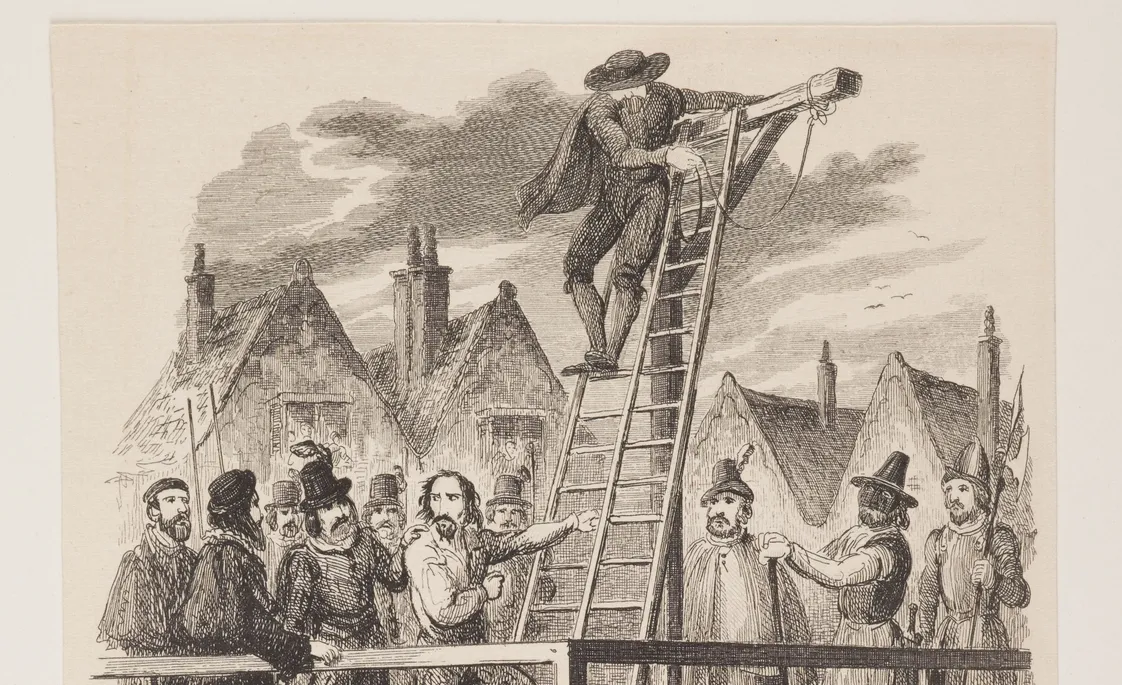14 October 2024 — By Iona Ball
Ghosts & ghouls of London’s Docklands
Explore chilling tales from 19th-century London’s Docklands, featuring the eerie laughing ghost of Limehouse and the infamous terror of Spring-heeled Jack.
Hallowe’en has evolved tremendously over the centuries. Here it’s believed to have begun as the Celtic festival of ‘Samhain’ (pronounced sow-in), which marked the end of the harvest and the beginning of preparations for winter.
It went on to take the form of the Christian ‘All Hallows Eve’ – marking the night of prayers before All Saints’ Day. And over time (with a little help from capitalism), we have the more macabre and mischievous night we’re familiar with – kids trick o’ treat-ing, adults playing dress-up and theatrical releases of horror movies.
For us Visitor Experience hosts, the number of questions about ghosts in the museum building and the general area around Docklands sees a surge at this time. Jack the Ripper is, of course, a popular theme, but during our lamp-lit ‘Docks after Dark’ tour at London Museum Docklands, I focus on stories of ghouls, the supernatural and horror that bring fear and fright upon this fateful night. After all, in London’s Docklands, there are many such tales to be found.
Here are two of my favourites from London in the 1800s to whet the appetite.
The laughing Limehouse ghost

An etching of Limehouse by James McNeill Whistler.
The Limehouse of London’s past was a place of work and dwelling, with houses backed up against wharves, yards and docks. It’s amid this bustling setting, that a married couple moved into a new home, reportedly in 1827. Little did they know they’d find a mysterious housemate. An article from The Australian newspaper gives us the details.
“A Mr. and Mrs. Dickenson took a small house, in October last, at the upper end of Church-street; but scarcely had they passed the first half of the first night in it, when a sort of a loud chucking laugh (the very sound, which if you could fancy a grasshopper intoxicated, he would no doubt make,) was heard, proceeding as it seemed from the bed-room closet.”
Ghostly laughter is a tale often repeated around the world and this occasion certainly seems to have had the couple spooked.
“As a brace of undaunted constables kept watch, the cacophonous interruption apparently continued ‘till the whole set were fairly laughed to scorn’”
According to reports in paper such as the Morning Post, they explored the whole house “from top to bottom...The next night, at the same hour, the same fat chuckling laugh was heard, and…it appeared close to Mr. Dickenson's ear.”
On the third night, Mr Dickenson had had enough and sought the help of authorities, although they seemed to be able to do little to help. As a brace of undaunted constables kept watch in the apartment, the cacophonous interruption apparently continued “till the whole set were fairly laughed to scorn”.

The Limehouse Ghost covered in the Morning Post's January 1827 edition.
And so, rather than face this unsettling situation further, the couple left Limehouse and the house sat abandoned. There have been no further reports of this “ungentlemanly good-for-nothing goblin” since. But there are many tales of spectres appearing by the Thames, of wails echoing along her shores and peculiarities not so easily explained.
Spring-heeled Jack: The terror of London
Ghoul or gallivanter was a question on the mind of many Londoners in the mid-1800s when a spectre of “a most hideous and frightful appearance” was scaring the life out of people in dark alleyways.
The alarming descriptions of this character garnered them the nickname ‘Spring Heeled Jack’. One account from a witness described him as: “he wore a large helmet; and his dress, which appeared to fit him very tight, seemed to her, to resemble white oilskin.”

A booklet published by the Collector's Miscellany titled Spring Heeled Jack. The Terror of London in 1935.
Further descriptions of his actions were regularly repeated. He was “enveloped in a large cloak” and would spit blue flame from his mouth, with glowing red eyes. He would leap away from the scene clear over people’s heads and over walls – hence, the ‘spring heels’.
“There were many theories as to who or indeed what this person was”
Jack appeared many times around London, but also further afield around the country. Mostly the accounts were of what we might call ‘jump scares’ today, where he would simply spook someone. However, one unpleasant report described Jack with long metallic claws that scratched a woman named Jane Alsop, leaving her only when the police were called for.
There were many theories as to who or indeed what this person was. With their strange and demonic appearance, could they be a genuine ghoul? Perhaps, an acrobat would explain the incredible jumping ability? Different well-known figures were also on the list of suspects, such as the 3rd Marquis of Waterford.
Painting the town red
The Marquis (Henry de La Poer Beresford) had been deemed a likely candidate as he was a well-known mischief. He’s the supposed origin of the phrase ‘painting the town red’ after a particularly wild night in Melton Mowbray saw him and a group of friends vandalising the town and stealing a pot of red paint, daubing doors and gates with it running up quite the fine.
But was Jack real at all?
Was this all a case of mass hysteria or a tale retold to warn children to behave, or else Spring-heeled Jack might appear? Some investigators have suggested these theories. However, others have given more credence to the numerous eyewitness testimonies, concluding that there were likely many people over time, possibly including copycats, being labelled together as one entity.
It was over 60 years between the first sighting and the last report of Spring-heeled Jack in the UK, in Liverpool in 1904. Interestingly, during the Second World War, a distinctly similar character appeared many times in Prague. Was ‘Pérák, the Spring Man of Prague’ the same phantom who once roamed the streets of Limehouse?
This is all perhaps more a matter of belief than of demonstrable truth.
For more tales of the macabre side of the Docklands, join us for the Docks After Dark tour.
Iona Ball is Visitor Experience Host at London Museum.





